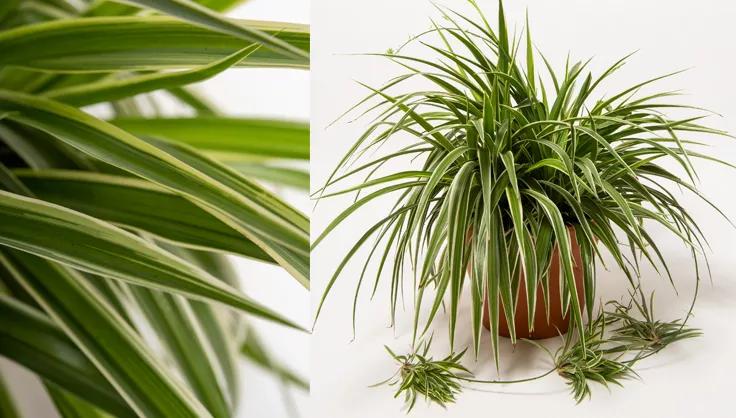How To Grow & Care For Spider Plants

Scientifically known as Chlorophytum comosum, the spider plant is native to southern Africa, where it lives in the humid understory of tropical forests. They are known for their long, slender leaves and the unique baby plants (pups or "spiderettes") that dangle from the mother plant. Its clump-forming shape and arching leaves allow the spider plant to be displayed in various ways, from windowsill to plant stand to hanging basket.
Popular Spider Plant Varieties
Spider plants are occasionally grown with solid green, strappy leaves, however variegated varieties are more common. Chlorophytum comosum ‘Vittatum’ has green foliage with a single off-white stripe down the center of each leaf. ‘Variegatum’ is the inverse of ‘Vittatum’, with an off-white stripe running along the edge of each green leaf. ‘Milky Way’ has a very wide, cream-colored center stripe. ‘Bonnie’ is a compact variety with curly leaves.
Best Growing Conditions For Spider Plants
Light: Spider plants grow best in a bright room, although they will tolerate medium levels of light. Variegated varieties will develop bolder stripes under brighter conditions.
Soil: Spider plants thrive in well-drained potting soil. A mix of regular potting soil with some perlite or sand works well.
Humidity: As a tropical plant, spider plants thrive in higher humidity levels. They can usually adapt to standard indoor conditions, provided they receive enough water.
How To Care For Spider Plants
Watering
Spider plants like lightly moist but not soggy soil — water once a week or so. Dry crispy tips often point to underwatering while dark brown tips indicate overwatering.
Fertilizing
Use a balanced, water-soluble houseplant fertilizer once a month during the growing season (spring and summer). Over-fertilized plants may not form as many spiderettes and may experience tip browning.
Pruning
Spider plants don’t require much pruning beyond an occasional trim to tidy up their appearance. Trim off brown leaf tips and remove dead or yellowing leaves.
Repotting
Repotting every 1-2 years helps maintain a healthy spider plant. Choose a pot that's slightly larger than the current one and has good drainage. Spider plants are excellent candidates for hanging baskets or wall planters, where their arching leaves and clumping spiderettes can gracefully hang down.
Propagating
Spider plants are easy to propagate! Simply snip off a spiderette and plant it in soil, or let it root in water first. They usually start to root within a week.
Common Problems with Spider Plants
Spider plants are quite resistant to pests but keep an eye out for common houseplant pests like spider mites or aphids. Spider plants are prone to tip burn, which can be caused by dry soil, low humidity, or a buildup of salt and chemicals found in some public tap water. Keep the soil slightly moist. Avoid watering with fluoridated or chlorinated water, and cut off brown tips if they do occur.
Toxicity
Good news! Spider Plants are non-toxic to pets, making them a safe choice for households with furry friends.
Spider Plants FAQs
Q: Why are the tips of my Spider Plant's leaves turning brown?
A: This is often due to fluoride in tap water, dry soil, or low humidity. Try using filtered water and maintaining consistent soil moisture.
Q: How can I encourage more spiderettes?
A: Provide adequate light and occasionally feed your plant with a balanced fertilizer. Healthy, mature plants are more likely to produce spiderettes.
Q: Can I grow spider plants outside?
A: Yes, spider plants can be grown as perennials in zones 9-11. As a tropical plant, the spider plant is not adapted to cool temperatures and must be grown as an annual or houseplant in colder growing zones. Tuck them in a hanging basket or elevated planter to highlight their elegant draping form!
Spider plants have been gracing our homes with their elegant leaves and ease of care for many, many decades. As trendy as today as it was years ago, the spider plant is a breeze to propagate (more plants!) and incredibly fun to display.
Print this Article:
Get the Dirt
Stay up to date on new articles and advice. Please fill out the information below.
